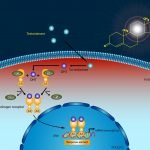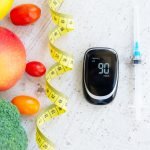Detoxification for Prediabetes
Sarah Cimperman, ND
Toxic compounds permeate our environment and they permeate our bodies. Almost 500 different chemicals have been found in human blood and adipose1 and studies show that the older we get, the more toxins we contain.2 Several are recognized as diabetogens because they have been associated with an increased risk of developing type 2 diabetes mellitus (T2DM). During the most recent National Health and Nutrition Examination Survey (NHANES), researchers detected diabetogens in every single sample from the 2500 people tested.3 More people are at risk for T2DM than ever before. As recent as 2010, prediabetes affected 79 million people in the United States, or 1 in 3 adults.4 To treat it successfully, the environmental component must be addressed. Detoxification is an important part of a comprehensive treatment plan to reverse prediabetes.
Environmental Toxins
Toxins associated with an increased risk of T2DM include pesticides, bisphenol A, phthalates, dioxins, perfluorinated chemicals, brominated flame retardants, volatile organic compounds, and heavy metals.
In the United States, more than 5 billion pounds of pesticides are applied to our crops every year.5 Pesticides act as endocrine disruptors, mimicking endogenous hormones, blocking hormone receptors, and/or acting as estrogens in insulin-producing beta cells and insulin-sensitive tissues, which can trigger hyperinsulinemia and insulin resistance.6
Bisphenol A (BPA) is used to make epoxy linings inside food and beverage cans, as well as polystyrene and polycarbonate (a hard, clear plastic). These materials are found in water bottles, baby bottles, pizza boxes, Styrofoam cups, egg cartons, takeout containers, plastic wrap, and other plastic items. BPA also has multiple industrial uses. When it escapes from landfills, it can contaminate drinking water, fish, and seafood. BPA acts as an endocrine disruptor and increases the risk of T2DM.6
Phthalates are chemicals that add flexibility to plastics. They’re used to make epoxy-lined cans, plastic food and beverage containers, plastic wrap and other plastic items, as well as personal products, paint, and many other things. Phthalates act as endocrine disruptors and increase the risk of T2DM.6
Dioxins include polychlorinated biphenyls, polychlorinated dibenzofurans, and polychlorinated dibenzodioxins, all of which are produced by a variety of industrial processes. Once they’re released into the environment, they contaminate soils and waterways and accumulate in our food. The greatest source for most people is contaminated fish and seafood, and the highest concentrations are found in predators at the top of the food chain. Dioxins act as endocrine disruptors, alter glucose homeostasis, and increase the risk of T2DM.7
Perfluorinated chemicals (PFCs) make materials stain- and stick-resistant. Several PFCs exist, but the 2 most common are perfluorooctanoic acid and perfluorooctane sulfonate. They leach into our food from nonstick cookware and food packaging like pizza boxes, microwave popcorn bags, and fast food containers. They’re also found in fabric, furnishings, household cleaners, and personal care products. Increased blood levels of PFCs have been associated with hyperinsulinemia and insulin resistance.8
Brominated flame retardants (BFRs) are added to furniture, electronic equipment, mattresses, and clothing. Because they don’t break down easily, they’ve become persistent and widespread in the environment. BFRs act as endocrine disruptors and studies have linked them to prediabetes, T2DM, and obesity.9
Volatile organic compounds (VOCs) are chemicals used in manufacturing. They escape in the form of gases from building materials, furnishings, office equipment, household cleaners, and fragranced products like air fresheners and scented candles. According to the Environmental Protection Agency, VOCs are up to 10 times more concentrated in indoor air than in outdoor air.10 Studies show that they promote high levels of blood glucose and insulin resistance.11
Heavy metals enter our diet primarily through drinking water, fish and seafood, and produce sprayed with herbicides or grown in contaminated soil. We can also be exposed to heavy metals from many other sources including antiseptics, dental amalgams, and cigarette smoke. Arsenic, cadmium, nickel, and mercury can increase blood glucose levels, damage beta cells, and interfere with insulin-stimulated glucose uptake by altering signaling transduction factors.12
Prediabetes Detox Program
For patients with prediabetes, the primary goals of detoxification are to remove underlying contributing factors (including environmental toxins, inflammation, high levels of cortisol, low levels of vitamin D) and to initiate permanent improvements in diet, exercise, and lifestyle habits. The Prediabetes Detox Program can be broken down into 3 components: diet, supplements, and lifestyle. The detox diet along with good sleep and stress management reduce inflammation and help keep glucose and insulin levels low, prompting the body to burn fat for energy and mobilize toxins stored inside adipose cells. Supplements and activities like exercise and sauna therapy optimize liver function and elimination, prompting the body to excrete mobilized toxins. Patients should follow the detox program for at least 2 weeks and until their morning fasting glucose levels are consistently
87 mg/dL or lower,13 up to 8 weeks.
Detoxification is contraindicated in pregnancy, breastfeeding, kidney disease, liver disease, cardiac arrhythmia, unexplained abdominal pain, acute inflammation of any part of the gastrointestinal tract, recent surgery or chemotherapy, and constipation (having less than 1 bowel movement per day).
Prediabetes Detox Diet
The prediabetes detox diet consists of 3 satisfying meals each day and a 12-hour overnight fast. Patients should eat organic whenever possible. When it isn’t possible, they should avoid the “Dirty Dozen Plus” most contaminated fruits and vegetables.14 Patients should eat whole foods only, choose fish and seafood that are low in toxins and high in omega-3 fats,15 and consume only wild, pasture-raised, and grass-fed meat, eggs, and animal products, or none at all.
Every day patients should include in their diet fermented foods, liver-supportive foods (eg, at least 2 cups of cruciferous vegetables, dandelion greens, artichokes, beets, and/or berries) and ground flaxseed (2 tbsp). Ground flax seeds reduce the absorption of carbohydrates, help eliminate toxins in the stool, support the growth of healthy bacteria, and improve insulin sensitivity and blood sugar control.16 Patients who do not tolerate ground flaxseed can substitute psyllium husk powder, which has also been shown to lower high levels of blood glucose and insulin.17
Patients are encouraged to season their food with herbs and spices shown to improve glucose control, reduce inflammation, and support detoxification, including garlic, onions, cinnamon, ginger, cayenne, fenugreek, cumin, turmeric, black pepper, parsley, cilantro, vinegar, and citrus zest.18-24 Each day they should drink plenty of filtered water (half their body weight in ounces) including 3 or more cups of unsweetened tea (green, white, rooibos, dandelion, or ginger).
Dairy products are optional. Patients who have a known or suspected sensitivity or intolerance should avoid all dairy products during detox. For patients who tolerate dairy well, certain products are allowed (eg, plain whole-milk yogurt, aged and ripened cheeses, butter, and cream) because they can be good sources of amino acids, conjugated linoleic acid, omega-3 fats, beneficial bacteria, and whey, which has been shown to boost levels of glutathione in the liver and lower levels of cortisol.25
Patients should avoid all processed foods, sweet foods and drinks (whether naturally or artificially sweetened), and starches including grains, root vegetables (except beets), and fruit (except whole unsweetened berries and some citrus). They should also avoid inflammatory fats (ie, deep-fried foods, butter substitutes, hydrogenated and interesterified oils, trans fats, and liquid oils that have not been cold-pressed) and foods and beverages in contact with plastic, polystyrene, and nonstick surfaces.
Prediabetes Detox Supplements
Supplementation is an important part of the Prediabetes Detox Program because it ensures that patients are getting the vitamin, mineral, amino acid, and antioxidant support needed for the mobilization, detoxification, and elimination of environmental chemicals. Dozens of different supplements can be helpful during detox but the Prediabetes Detox Program utilizes the 8 most important for patients with prediabetes: a multivitamin/mineral formula; extra vitamin C (2000 mg BID-TID), extra magnesium (400 mg BID), vitamin D (1000 to 2000 IU QD), alpha-lipoic acid (600 mg BID), omega-3 fats (2000 mg DHA+EPA QD), probiotics (10 billion cfu QD), and a botanical formula for liver support, including herbs like Silybum marianum (milk thistle), Taraxacum officinale (dandelion), and Arctium lappa (burdock).
Protein powder is not a standard part of the Prediabetes Detox Program because patients are advised to avoid processed foods and grains. However, certain patients benefit from a protein supplement, including those who follow a vegan diet and anyone who doesn’t get enough protein from dietary sources. Whey is one good option and a vegan-friendly alternative is a combination of hemp, pea, and rice protein.
Some patients may require additional supplements based on their environmental exposure and individual needs. Those with documented heavy metal toxicity will need to be counseled on chelating agents and supportive supplements like vitamin E, selenium, N-acetylcysteine, and modified citrus pectin. Patients who don’t drink enough tea can take green tea in capsule form.
Prediabetes Detox Lifestyle
The lifestyle component of the Prediabetes Detox Program focuses on reducing or eliminating factors that increase inflammation, raise glucose and insulin levels, and increase the risk for T2DM (such as smoking26 and stress) while increasing activities that promote elimination, lower glucose and insulin levels, and decrease the risk of T2DM (like exercise, stress management, sleep, and sauna therapy).
Detox can be a good opportunity for smokers to quit. Nearly 90% of those who stop successfully quit abruptly. The cold turkey method has actually been shown to be twice as effective as medication and nicotine replacement therapy,27 which can increase levels of insulin and promote insulin resistance.28
Stress can be managed in a variety of ways, including exercise, yoga, breathing exercises, meditation, self-hypnosis, guided imagery, progressive muscle relaxation, massage, and qigong.
During detoxification and until fasting glucose levels are consistently normal, patients should exercise 5 hours each week and incorporate aerobic exercise, strengthening exercises, interval training, and stretching. Studies show that the combination of aerobic and strengthening exercises are much more effective at lowering hemoglobin A1C levels than either type of exercise alone.29 Strengthening exercises also improve the sensitivity of insulin receptors on cells, allowing them to take up glucose from the blood more efficiently and significantly reduce the risk of developing T2DM. Interval training is the practice of alternating short bursts of higher-intensity physical activity with periods of lower-intensity activity. It stimulates the body to burn more fat,30 increases exercise capacity,31 and can be done with almost any activity. Patients can start by adding 1 high-intensity interval of 30 seconds to their exercise routine and gradually work their way up to 3 high-intensity intervals of 1 to 4 minutes each (spaced at least 4 minutes apart), 3 times per week.
Patients should get at least 9 hours of sleep each night during detox. Short sleep cycles increase glucose levels, cause cells to lose sensitivity to insulin, and increase the risk for T2DM.32 Research studies show that when we sleep 7 seven hours or less overnight, epigenetic changes prompt our bodies to store fat, but when we sleep 9 hours or more, epigenetic influences on body weight are suppressed.33
Patients are encouraged to do 6 to 7 treatments per week of either infrared sauna (one 20-minute session) or traditional sauna (one to four 15-minute sessions). They should drink 8 ounces of filtered water, ginger tea, or coconut water before and after each session; follow each session with a 30-second cold shower, washing their bodies well to remove secreted toxins; and relax for 20 minutes or more after each treatment. To replace lost electrolytes, they should consume at least 2 cups of foods rich in electrolytes at their next meal (eg, celery, broccoli, artichokes, mustard greens, spinach, sardines, haddock, wild Alaskan salmon).
As part of the Prediabetes Detox Program, patients are also encouraged to “detox” their home environment and minimize unnecessary exposure to common chemicals. A full Home Detox Checklist is available at http://adifferentkindofdoctor.blogspot.com/2011/12/home-detox-checklist.html.
Food Reintroduction
After detox, patients should continue eating the detox diet while they systematically reintroduce the whole foods they have been avoiding (like fruit, starchy vegetables, and whole grains) and monitor effects on blood glucose levels (upon waking and 2 hours after each meal). They should continue to avoid processed foods and any foods causing elevations in glucose exceeding 120 mg/dL 2 hours postprandial. Patients can also test foods they have been avoiding because of suspected sensitivity, such as gluten and dairy products.
Also after detox, patients must be counseled on the importance of always eating a diet low in sweets and starches, exercising at least 3 hours every week, getting at least 8 hours of sleep each night, managing stress, taking supplements tailored to meet their individual needs, and repeating detoxification once or twice each year to permanently prevent T2DM and ensure optimal health.
 Sarah Cimperman, ND is the author of the new book, The Prediabetes Detox: A Whole-Body Program to Balance Your Blood Sugar, Increase Energy, and Reduce Sugar Cravings. She graduated from NCNM in 2002 and has a private practice in New York City. Her expertise has been featured on Fox News and in Natural Health Magazine, Whole Living magazine, and the Well Being Journal, among other publications. Dr Cimperman also writes 2 blogs: A Different Kind Of Doctor, and The Naturopathic Gourmet.
Sarah Cimperman, ND is the author of the new book, The Prediabetes Detox: A Whole-Body Program to Balance Your Blood Sugar, Increase Energy, and Reduce Sugar Cravings. She graduated from NCNM in 2002 and has a private practice in New York City. Her expertise has been featured on Fox News and in Natural Health Magazine, Whole Living magazine, and the Well Being Journal, among other publications. Dr Cimperman also writes 2 blogs: A Different Kind Of Doctor, and The Naturopathic Gourmet.
References
Environmental Working Group. Pollution in Minority Newborns: BPA and Other Cord Blood Pollutants. EWG Web site. http://www.ewg.org/research/minority-cord-blood-report/bpa-and-other-cord-blood-pollutants. Accessed September 10, 2013.
Hue O, Marcotte J, Berrigan F, et al. Plasma concentration of organochlorine compounds is associated with age and not obesity. Chemosphere. 2007;67(7):1463-1467.
Centers for Disease Control and Prevention. Fourth National Report on Human Exposure to Environmental Chemicals, Updated Tables. CDC Web site. http://www.cdc.gov/exposurereport/. Accessed September 10, 2013.
Centers for Disease Control and Prevention. Awareness of Prediabetes – United States, 2005-2010. CDC Web site. http://www.cdc.gov/mmwr/preview/mmwrhtml/mm6211a4.htm. Accessed September 10, 2010.
Environmental Protection Agency. 2000-2001 Pesticide Market Estimates: Usage. EPA Web site. http://www.epa.gov/pesticides/pestsales/01pestsales/usage2001.htm. Accessed September 12, 2013.
Alonso-Magdalena P, Quesada I, Nadal A. Endocrine disruptors in the etiology of type 2 diabetes mellitus. Nat Rev Endocrinol. 2011;7(6):346-353.
Wang SL, Tsai PC, Yang CY, Guo YL. Increased risk of diabetes and polychlorinated biphenyls and dioxins: a 24-year follow-up study of the Yucheng cohort. Diabetes Care. 2008;31(8):1574–1579.
Lin CY, Chen PC, Lin YC, Lin LY. Association among serum perfluoroalkyl chemicals, glucose homeostasis, and metabolic syndrome in adolescents and adults. Diabetes Care. 2009;32(4):702-707.
Casals-Casas C,Desvergne B. Endocrine disruptors: from endocrine to metabolic disruption. Annu Rev Physiol. 2011;73:135-162.
Environmental Protection Agency. An Introduction to Indoor Air Quality. EPA Web site. http://www.epa.gov/iaq/voc.html. Accessed September 10, 2013.
Hong YC, Park EY, Park MS, et al. Community level exposure to chemicals and oxidative stress in adult population. Toxicol Lett. 2009;184(2):139-144.
Chen YW, Yang CY, Huang CF, et al. Heavy metals, islet function and diabetes development. Islets. 2009;1(3):169-176.
Tirosh A, Shai I, Tekes-Manova D, et al. Normal fasting plasma glucose levels and type 2 diabetes in young men. N Engl J Med. 2005;353(14):1454-1462.
Environmental Working Group. EWG’s Shopper’s Guide to Pesticides in Produce 2013. EWG Web site. www.ewg.org/foodnews. Accessed September 10, 2013.
Environmental Defense Fund. EDF Seafood Selector. EDF Web site. www.seafood.edf.org. Accessed September 10, 2013.
Mani UV, Mani I, Biswas M, et al. An open-label study on the effect of flax seed powder (Linum usitatissimum) supplementation in the management of diabetes mellitus. J Diet Suppl. 2011;8(3):257-265.
Pastors JG, Blaisdell PW, Balm TK, et al. Psyllium fiber reduces rise in postprandial glucose and insulin concentrations in patients with non-insulin-dependent diabetes. Am J Clin Nutr. 1991;53(6):1431-1435.
Rani MP, Padmakumari KP, Sankarikutty B, et al. Inhibitory potential of ginger extracts against enzymes linked to type 2 diabetes, inflammation and induced oxidative stress. Int J Food Sci Nutr. 2011;62(2):106-110.
Ballali S, Lanciai F. Functional food and diabetes: A natural way in diabetes prevention? Int J Food Sci Nutr. 2012;63 Suppl 1:51-61.
Madkor HR, Mansour SW, Ramadan G. Modulatory effects of garlic, ginger, turmeric and their mixture on hyperglycaemia, dyslipidaemia and oxidative stress in streptozotocin-nicotinamide diabetic rats. Br J Nutr. 2011;105(8):1210-1217.
Sreelatha S, Inbavalli R. Antioxidant, antihyperglycemic, and antihyperlipidemic effects of Coriandrum sativum leaf and stem in alloxan-induced iiabetic rats. J Food Sci. 2012;77(7):T119-T123.
Bolkent S, Yanardag R, Ozsoy-Sacan O, et al. Effects of parsley (Petroselinum crispum) on the liver of diabetic rats: a morphological and biochemical study. Phytother Res. 2004;18(12):996-999.
Johnston CS, Steplewska I, Long CA, et al. Examination of the antiglycemic properties of vinegar in healthy adults. Ann Nutr Metab. 2010;56(1):74-79.
Victor Antony Santiago J, Jayachitra J, Shenbagam M, Nalini N. Dietary d-limonene alleviates insulin resistance and oxidative stress-induced liver injury in high-fat diet and L-NAME-treated rats. Eur J Nutr. 2012;51(1):57-68.
Markus CR, Olivier B, Panhuysen GE, et al. The bovine protein alpha-lactalbumin increases the plasma ratio of tryptophan to the other large neutral amino acids, and in vulnerable subjects raises brain serotonin activity, reduces cortisol concentration, and improves mood under s tress. Am J Clin Nutr. 2000;71(6):1536-1544.
Rafalson L, Donahue RP, Dmochowski J, et al. Cigarette smoking is associated with conversion from normoglycemia to impaired fasting glucose: The Western New York Health Study. Ann Epidemiol. 2009;19(6):365–371.
Doran CM, Valenti L, Robinson M, et al. Smoking status of Australian general practice patients and their attempts to quit. Addict Behav. 2006;31(5):758-766.
Eliasson B, Taskinen MR, Smith U. Long-term use of nicotine gum is associated with hyperinsulinemia and insulin resistance. Circulation. 1996;94(5):878-881.
Church TS, Blair SN, Cocreham S, et al. Effects of aerobic and resistance training on hemoglobin A1c levels in patients with type 2 diabetes: a randomized controlled trial. JAMA. 2010;304(20):2253-2262.
Talanian JL, Galloway SD, Heigenhauser GJ, et al. Two weeks of high-intensity aerobic interval training increases the capacity for fat oxidation during exercise in women. J Appl Physiol (1985). 2007;102(4):1439-1447.
Burgomaster KA, Hughes SC, Heigenhauser GJ, et al. Six sessions of sprint interval training increases muscle oxidative potential and cycle endurance capacity in humans. J Appl Physiol (1985). 2005;98(6)1985-1990.
Knutson KL, Van Cauter E. Associations between sleep loss and increased risk of obesity and diabetes. Ann N Y Acad Sci. 2008;1129:287-304.
Watson NF, Harden KP, Buchwald D, et al. Sleep duration and body mass index in twins: a gene-environment interaction. Sleep. 2012;35(5):597-603.










